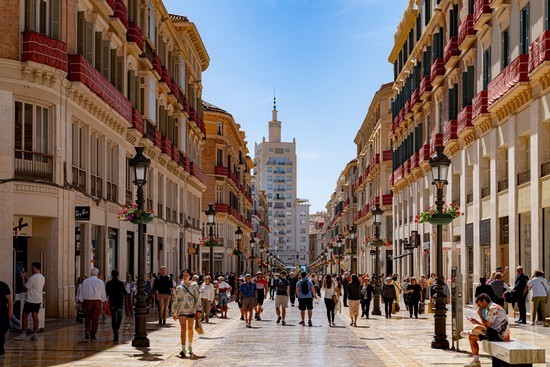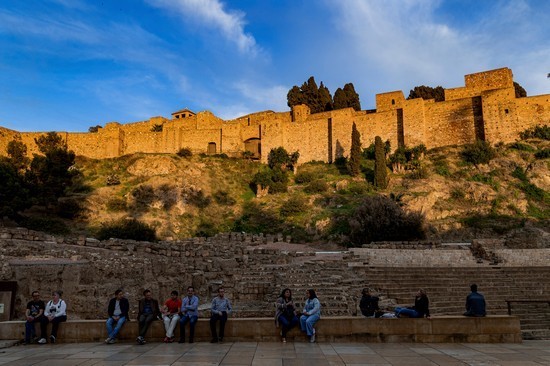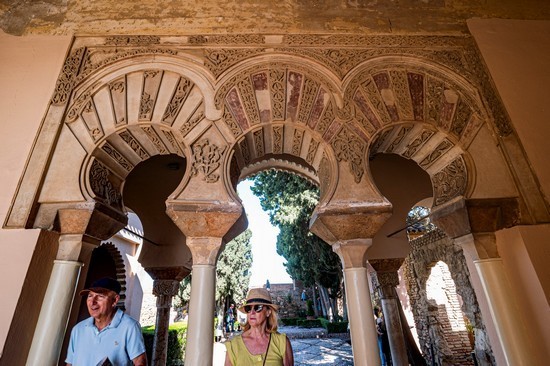In honor of this year’s 50th
anniversary of the death of Pablo Picasso, museums and other cultural
institutions are pulling out all the stops, with about 50 exhibitions and
events in the US and Europe. Some offer novel perspectives on the celebrated
artist’s seven-decade career: At the Cincinnati Art Museum, “Picasso
Landscapes: Out of Bounds” focuses exclusively on the artist’s landscapes,
while at the Musée Picasso, Paris, the British menswear designer Paul Smith has
added bold stripes and saturated hues to the walls where some of Picasso’s best
known masterpieces are displayed.
اضافة اعلان
 Calle Larios, a
beloved pedestrian shopping street in Malaga, Spain.
Calle Larios, a
beloved pedestrian shopping street in Malaga, Spain.
But one of the best places to discover
pre-celebrity Picasso is his hometown, Málaga, the Andalusian port city on the
southern Mediterranean coast of Spain. This is where the artist was born and,
long before he became a household name, where his extraordinary artistic talent
became evident to his father, José Ruiz Blasco, a painter and an art teacher,
and the rest of his family, as well as their circle of artist friends.
“He adored Spain and always honored his Andalusian roots,” said his grandson, Bernard Picasso, in a telephone interview. “You can see it in the colors he used, the bullfighting imagery, the Mediterranean.”
Though the family relocated to A Coruña in
northern Spain when Pablo was nine years old, and he would go on to study and
live in Madrid and Barcelona before settling in Paris in 1904, Picasso always
considered himself a malagueño. Many of the themes first depicted in his youth
would continue to appear in his art until the end of his life.
“He adored Spain and always honored his Andalusian
roots,” said his grandson, Bernard Picasso, in a telephone interview. “You can
see it in the colors he used, the bullfighting imagery, the Mediterranean.”
Picasso last visited Spain in the
mid-1930s, shortly before the Spanish Civil War, which ended in 1939 with Gen.
Francisco Franco establishing a military dictatorship that endured nearly 40
years, outlasting Picasso’s own life by more than a year. The artist, who
abhorred the repressive regime, never returned to his homeland again.
 The historic Alcazaba
fortress in Malaga, Spain.
The historic Alcazaba
fortress in Malaga, Spain.
Were he to turn up in Málaga today, Picasso
might be shocked to find a museum bearing his name — the Museo Picasso Málaga
opened in 2003 and now draws nearly 700,000 visitors a year. Then again, given
his reputation for having an outsize ego, maybe he would not be surprised at
all by the museum, though he would likely be charmed to find his childhood
home, the square where he used to play, the church where he was baptized, as
well as the art academy where his father taught — not to mention the city’s
famous bullring, cathedral and other landmarks — pretty much just as he left
them.
History and the artist’s brushI chose to begin my 2023 Picasso immersion tour
in Málaga, though not at the Picasso Museum or even at the artist’s childhood
home, itself a charming museum. Instead, I started by climbing the hundreds of
stairs that rise from Málaga’s first-century BC Roman theater to the Alcazaba,
the Moorish hilltop fortress begun in the 11th century that overlooks the city
and port from Mount Gibralfaro. Besides the sweeping views it offers of the
entire city, the fortress is emblematic of the layering of Mediterranean
history, symbols, and mythology that Picasso would employ repeatedly in his
art.
The Moors essentially used the Roman
theater as a stone quarry to build the Alcazaba, which appears as a fortress on
the outside, but inside shelters a sprawling series of rooms, patios, arcades,
lush plantings, and countless gurgling fountains. It goes a long way to
revealing the idyllic aspects of the Mediterranean lifestyle and reinforces the
city’s identity as a truly ancient hub of Mediterranean civilization, which
began with the Phoenicians, who first established the settlement they named
Malaka in the seventh century BC.
That deeply layered Mediterranean heritage is abundant in Picasso’s many self-referential takes on such classical themes as the Minotaur, Pan, and the idealized seaside Arcadian mythology with which he identified
That deeply layered Mediterranean heritage
is abundant in Picasso’s many self-referential takes on such classical themes
as the Minotaur, Pan, and the idealized seaside Arcadian mythology with which
he identified, and sometimes employed to portray his family, throughout his
life.
The city and the homeMy next stop was the Museum of Málaga in
its gorgeous new home in the city’s former customs house, which, while it does
not have the name Picasso in the title, offers a fuller picture of the city’s
artistic history before its most famous native son arrived on the scene. The
museum, which reopened in its new location in 2016, provides an amazingly
thorough and detailed chronicle of Málaga from the earliest days of classical
antiquity to well into the 20th century. There is a particularly wonderful
display and explanation of the city’s cultural boom in the 19th century, when
local artists excelled at portraiture and historical painting, and also depicted
Málaga’s social gatherings and revelry. Paintings of elegant garden parties,
moonlit festivities on the beach, and raucous celebrations after bullfights
offer a delightful snapshot of the city’s ebullient fin-de-siècle social and
cultural scene.
 Visitors in the historic
Alcazaba fortress in Malaga, Spain.
Visitors in the historic
Alcazaba fortress in Malaga, Spain.
“Everyone asks how this creative genius
could have come out of sleepy Málaga,” said Ana Gonzalez, a guide who left her
job in the museum world to found a tour company, Arteduca Málaga, that works
with multiple museums and sites to offer a more comprehensive approach to the
city, including Picasso’s place within it.
“The reality is that Picasso was born in
the right place, at the right time and in the right context. His father was an
artist and teacher of painting, and many of his friends were artists who knew
to encourage and foster the young boy’s talent,” she said. “When Picasso showed
promise as a draftsman, he was given all the materials he needed.”
While not exactly among the city’s new
movers and shakers — Picasso’s father often struggled financially — the Ruiz
Picasso family enjoyed relative middle-class comfort as evidenced by a visit to
Casa Natal, a small museum in the house where Pablo was born. Downstairs, an
exhibition space focuses mostly on his prints and drawings as well as several
of the artist’s sketchbooks. But it really sets the scene with insightful
Picasso quotes — “I have never done children’s drawings. Never. Even when I was
very small” — and archival photos covering many aspects of Picasso’s life, from
his childhood in Málaga to later candid shots from restaurants and bullfights
in the South of France, and wonderful images of him playing on the beach or
bobbing in the sea with his young children. Upstairs are period furnishings,
family heirlooms, and more stories about the family’s life in Málaga.
“The reality is that Picasso was born in the right place, at the right time and in the right context. His father was an artist and teacher of painting, and many of his friends were artists who knew to encourage and foster the young boy’s talent.”
The house sits at the corner of the Plaza
de la Merced, which had an outdoor market in Picasso’s day, so it would have
been a colorful and lively place to grow up. Steps from the plaza on Calle
Granada is the Parish Church of Santiago Apostal (St. James the Apostle), where
Picasso was baptized as a baby. The 16th-century church has a relatively humble
facade and a far more ornate interior, with curlicue frosting-like stucco
reliefs animating the vaulted ceiling, and a handsomely carved wooden retablo
over the altar painted a somber shade of olive green. The very simple baptismal
font stands near the rear of the church and might be missed if one is not on
the lookout for it.
Sculpture and styleA hundred yards or so from the church is
the entrance of the Museo Picasso Málaga, which features a chronological and
thematic overview of the artist’s career, as well as various special
exhibitions each year, some dedicated to the charming ceramics Picasso started
creating in Vallauris, France, just after World War II. Another gallery
typically displays photographs of the artist and his life made by many of the
great 20th-century photographers whom he befriended and who had privileged
access to him and his family. Opening May 8, the special exhibition “Picasso
Sculptor: Matter and Body” is surprisingly the first major exhibition in Spain
to focus on the artist’s sculptures.
 A tapestry version of
Picasso’s 1907 painting “Les Demoiselles d’Avignon” woven by Jacqueline
Dürrbach, at the Museo Picasso Málaga.
A tapestry version of
Picasso’s 1907 painting “Les Demoiselles d’Avignon” woven by Jacqueline
Dürrbach, at the Museo Picasso Málaga.
The building housing the museum was a 16th-century
nobleman’s handsome stone palace, now deftly expanded by the New York architect
Richard Gluckman to seamlessly blend with the city’s whitewashed buildings.
With two floors of galleries around a pretty marble courtyard of the
Renaissance palace, the museum tells the story of Picasso’s career with about
250 works — many donated to the museum by Christine Picasso (the wife of
Picasso’s oldest son, Paulo) and her son, Bernard.
What astonishes many visitors is not merely
the chronological sweep of the artist’s career (more than 70 years) but the
range and diversity of painting styles (many of which he invented) and the
seemingly boundless materials he transformed into art. There are painted roof
tiles; charming sculptures made from bits of scrap metal artfully folded into
evocative figures; and ceramic platters transformed into bullrings, with the
audience “seated” around the plate’s elevated border and the bullfight
occupying the center.
Read more Culture and Arts
Jordan News



